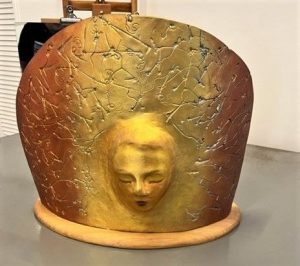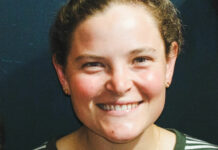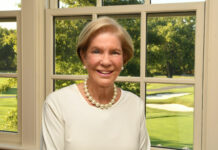Edna Kurtz Emmet retired recently from the Waldorf School of Baltimore, where she taught art for 33 years.

Although she no longer teaches in an academic setting, she remains active, creating artistic pieces that inspire, intrigue and provide insight into the human experience and her creative process.
The 73-year-old Baltimore City resident welcomed the JT to her downtown, Baltimore Street studio on a sunny Sunday afternoon. Several of her paintings and sculptures are displayed in the bright, well-lit space, where she held an Open Studio this past fall.
The sculptures, explained Emmet, are designed to be interactive. For example, “Panim Pnim” (“Face Inward”) is a facial work that when turned reveals an interior face, thus capturing the meaning of the word panim, which means “face” in Hebrew, and pnim, which means “inside.”
She said the sculpture represents the multifaceted elements of the human experience and of getting to know another human being. On her website, she writes about such art capturing “the moment between our outer countenance/the face and the inner forces pushing and pressing the skull from within … the bridge between the outer world and the inner experience.”
She added that the sculptures capture that which we reveal to the world and that which remains hidden. The interactive process comes in as “these sculptures need to be viewed in the round, from all sides.”
The artist’s life has been a whirlwind of experiences and activities. She was born in Poland to parents who suffered devastating losses during the Holocaust. Emmet’s father, Haim Henrick Kurtz, was born in Lodz and worked as an engineer for the agriculture department in Poland. After the Nazis invaded the country in September 1939, her father and mother, Danuta Nightingale, were forced into the ghetto and later into work camps, and eventually, transported to concentration camps.
Emmet shared that while her father initially tried to convince his family to leave Poland, they were unable to do so. The only survivors of the Holocaust on her father’s side were him and two of his brothers; and on her mother’s side, just she, and her brothers and sisters. Her story is particularly poignant with the approach of International Holocaust Remembrance Day on Friday, Jan. 27.

‘Israel became our home’
When Emmet was 8 years old, her parents moved to Israel. “Our parents’ generation were all displaced, all traumatized people. But as young children, we were not fully aware of the implications. There were a lot of children and young people, after the war, and no old people because they had all been killed.”
She remembered a desire to become Israeli very quickly, recalling those years as open and welcoming — the children had been welcomed into Israel with open arms. It was, shared Emmet, “magical, because the country held us as the future, and gave us all this freedom and respect. There was pride in everything we did. Israel became our home.”
And where the nights for Emmet the child consisted of hearing screaming from the nightmares of adults, for Emmet the artist, her nights became, she said, “a place where I can get myself surprised by giving birth to things that didn’t exist before.”
Emmet joined the Israel Defense Forces when she turned 18, and after her service was over 20 months later, she began a life of travel.
She studied in London, obtaining a diploma in art and design from the Hornsey College of Art in 1973, and later spent two years at the Shogengi Zen Buddhist Temple in the Gifu Prefecture, Japan. She lived in Greece, returned to Israel and then traveled to Switzerland, where she got a certificate from the Beppe Assenza studio in Dornach in 1986. A decade later, she earned a Certificate in the Applied Arts Program at Sunbridge College in Spring Valley, N.Y.
‘Life is for the living’
Of her local teaching experience, she said that she enjoyed working with children the most, adding, “I loved their openness — their pure force of creation that just needed to be guided, once given the space so that they can create.”
Emmet’s retirement party was not the usual get-together of fond farewells. The reception consisted of an exhibit that included art pieces created by more than 70 of her former art students. She describes the Waldorf School as a magical place, remarking that “the people who gravitate to that place are very special,” from the students to the staff.
She remains keenly aware of the past that shaped her, and as such, celebrates the vibrancy of life around her — in the people she meets and in her art. “Life is for the living; the ones who are alive should make the best of life.”
Emmet’s open, welcoming demeanor is also reflected in the way she creates art. “I explore how colors and spaces can evoke a sense of beginnings, of potentiality and of stories coming into being and dissolving simultaneously. I apply colors and delve into their sensuality and their effects on my psyche. While exploring the various spaces, I leave behind a road map of experiences that occurred along the way. I energize the surface until I feel as if the paint is pushed up towards me and the space between the painting and my eyes is alive. My intent usually is to avoid concrete imagery so that viewers will develop their own unique relationship with a painting.”
Emmet has held exhibitions all over the world — from Japan, to Iceland and throughout America. In 2021, she was part of a group exhibition titled “Jewish Authenticity and Identity,” held in Washington, D.C.
She has two adult children: Nadav Kurtz, a filmmaker in Los Angeles; and Danielle Emmett, a physician in New York and who, on the day of this interview, gave birth to Emmet’s first grandchild, Levi.







